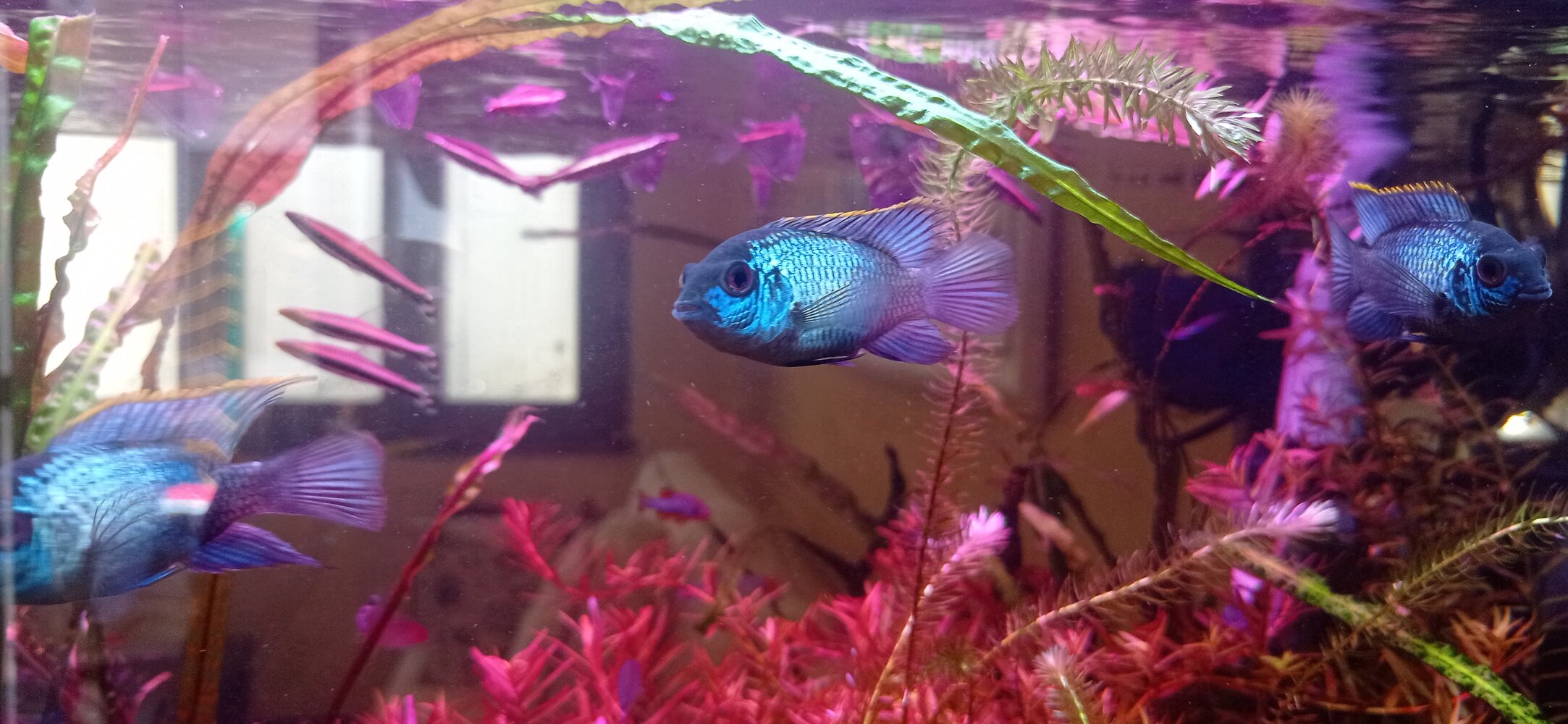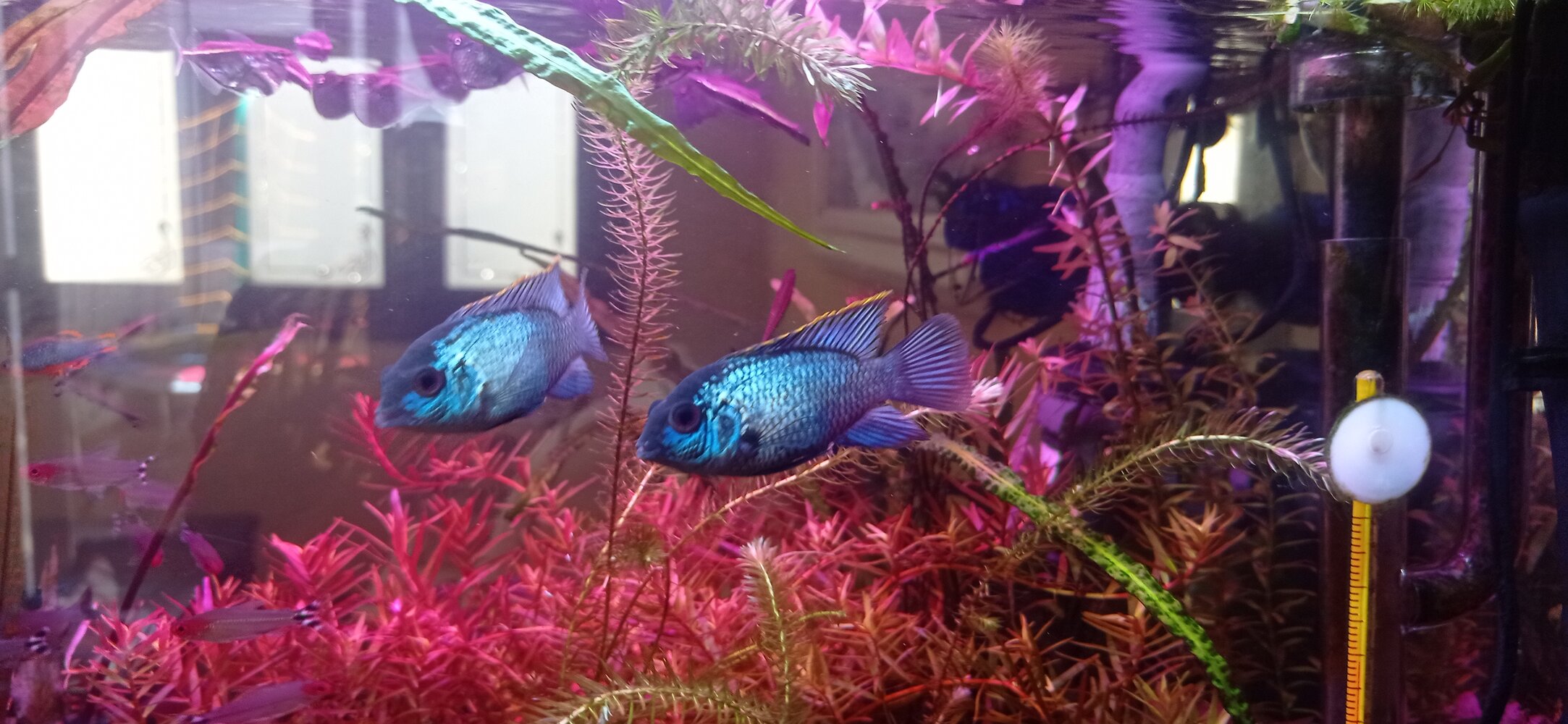Hello! It's been a while since I last posted here, but mostly because nothing noteworthy came up and things are not as well as I would hope.
No effort was made to make the tank any more presentable for the pictures haha. In fact, only when looking at them in the computer that I noticed that the glass could go with some algae scrapping. In order to take the pictures without all the usual reflexes, I turned the lights to full when it was almost done fading off at night, and the fish didn't enjoy that all that much.
For a long while now I have been slowly reducing the ferts, moving from something inspired by EI to something closer to lean dosing. In the most recent iteration, which I believe should be the final step of this change, I followed Happi's suggestions as much as I could, while using my tap water. I don't have my spreadsheet here right now, but I'm now at a position with K < Mg < Ca, and a significant reduction of phosphorus from what I had at the very start. I also stopped adding any Ca to the water, since my tap water comes with a GH of 3, which I'm assuming, without any evidence, that it is mostly Ca. I reduced Mg a bit to compensate for the reduction of Ca.
My plants were never an example of health and happiness, but they survive and grow, so it us both good and bad news that in practice I haven't noticed any significant change throughout this whole change. Oh, I also recently stopped adding extra Boron, which I did add for a very long time. As with most of my changes, adding Boron (in addition to my micro mix, which adds a particularly small amount of B) didn't change anything significantly. In fact, if anything, I got the feeling that some plants developed curved leaves, but I can't really associate one thing with the other. As always, when using tap water, we really don't know what sort of micros could be present already... Especially around here, where we don't get water quality reports of any use.
I installed an automatic doser, the cheapest I could find. It is now responsible for adding Fe, micros and urea, a little bit every day. I feel it was a positive change, but I'm still struggling with this doser, it has the weirdest tendency to form air pockets inside the tube, but starting from the center, not from the ends. I have to purge the lines every now and then. I have two theories, but neither convince me very much. Either the silicone tubing is permeable to air, or the union between the silicon tubing and the small tubing strip that goes through the doser is allowing air to sip in. But it looks like a very tight union. I have PU tubing that I use for CO2, but it is not transparent. I suppose I could try to get some clear LDPE tube. I'm aware that this all involves the check valves being crap, but it still doesn't explain how the bubbles are forming from the center of the tubing.
Layout-wise, I have been having issues with rooting plants, both in my plateau intended for carpeting plants and on the corner that was meant to be a place for stem plants. Both these regions ended up with only thin layers of substrate, and this brand I used in my last modification in these areas feels very light, it doesn't hold the plants well. With my ever growing army of Cory sterbais, with 4 plecos (or was it 5?), the garra flavatras and now the blue acaras, the plants don't stand a chance when trying to root to a new place. After renovating the plateau, only the Echinodorus aflame and a single staurogyne manage to stay in place. I tried multiple times to replant the area and to protect the plants with toothpick walls, but it didn't work. Now I'm hoping this single staurogyne will spread. Whoever finds a lost toothpicks in the pictures get an extra point!
Yesterday I had it with the stems corner. Only my rotalas and the Ludwigia verticilata survived, but they grew too fast and needed constant replanting of the tops. Sometimes I would get away just trimming and not replanting, but the result wasn't nearly as good as when I replanted the tops. And since it is getting harder and harder to replant the tops without the fishes pulling them all out, I gave up. All the stems are gone, as you may notice from the picture. I will give stems one last chance, I want to try Hemianthus micranthemoides. I never tried this plant before and I think it will form a dense bush, impenetrable to the fishes, and that I can trim it without having to replant the tops. I'll also try to form a well groomed bush of Microsorum trident. If it works, I'll undo the mess of Mirosorums that I have on the other side, they aren't attached to anything and in all honesty, I just chugged the plants there when I put this tank together, because I didn't know what to do with them, they didn't have a place in the layout and I didn't want to throw them all away.
I have plans to do a drastic trimming on the anubia nanas. They formed a dense wall of leaves in the narrow region between the rocks and the glass, and it is accumulating a lot of dirt in there. I have been making a point to try to vacuum as much as possible with water changes, but there is always more. The are still plagued with green spots and black spots, they have been since day one and this is my single largest frustration with this tank. The Echinodorus parviflorus made a comeback after almost dying for whatever reason. The crypts are all kind of OK, but not really. Except the balansae, which is trying to take over the world. I trim it aggressively, although it doesn't look like it. The Nymphaea is also huge. It is constantly losing small leaves, I don't know why, but it is also always growing despite me trimming grown leaves constantly. The pinattifidas stopped spreading for a few months after the mess that was the start of the year, but now they started growing again. And finally, the bolbitis sprout back from the beyond, after I thoroughly removed all of them in October. There must have been some very small piece of rhizome left somewhere and it just grew back.
As always, for some reason this tank is extremely resilient to algae, except for green spots. But even the green spots are less aggressive now, the fact that the glass isn't clean shouldn't be used as evidence against it, since I haven't cleaned it in more than a month.
Now for the fish talk. The sterbais are slowly increasing the herd, all on their own. Every time I try to interfere and collect some eggs to raise them in a safe place, I get nothing. But in the tank, it seems that the luckiest fry do get a chance to grow. The blue acaras got a second batch of fry. During the first one I was completely unprepared, so I mostly just let things happen in the main tank without interfering much. One week after the fry were free swimming, they were all gone. This time, as soon as the fry were swimming, I collected a few of them and moved them to another tank, where I try to feed them. As it happened before, the fry left in the tank are now all gone, but the ones I collected look to be doing well. I counted 18 of them, and as far as I can tell, I only lost one. It must be noted that every time the blue acaras spawn, they become very unfriendly to the layout, and played a big part in my frustration with replanting the stem plants.
The apple melanotaenias also lay eggs every now and then, but they simply become breakfast for the rest of the tank. I don't even know if they get fertilized or not, but with zero care for their safety, they don't stand a chance. In seconds they are gone.
Since I hadn't seen any of the kuhlis for a long time, at some point I just assumed they all died. In fact, when I started planning the change of the substrate on the plateau, one concern was that I would accidentally crush them or trap them. But when the time came, I already thought they were gone, so I didn't really take any special care. Then last week, out of the blue, I saw two of them, for only a brief moment. If there are 2, there may be more, who knows. And the same happened with the ghost shrimps, I assumed they all died after being missing for months, then one of these days I saw one...
Aaaand now things are up to date in this journal.





